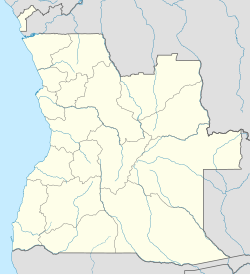Cuito Cuanavale | |
|---|---|
 Town hall | |
| Coordinates: 15°10′S 19°10′E / 15.167°S 19.167°E | |
| Country | |
| Province | Cuando Cubango |
| Area | |
| • Total | 35,610 km2 (13,750 sq mi) |
| Population (2014)[1] | |
| • Total | 40,829 |
| • Density | 1.8/km2 (5/sq mi) |
| Time zone | UTC+1 (WAT) |
| Climate | Cwa |
Cuito Cuanavale, occasionally spelt Kuito Kuanavale or Kwito Kwanavale, is a town and municipality in Cuando Cubango (Kuando-Kubango) province in Angola.
The area around the town was the scene of heavy fighting during various campaigns during the Angolan Civil War and the South African Border War, with the Battle of Cuito Cuanavale from 1987 to 1988 being the largest land battle in Africa since World War II.
YouTube Encyclopedic
-
1/2Views:232 049598 593
-
The 23 Year Long War the World Forgot About - The South African Border War
-
Battle of Cuito Cuanavale - 1987
Transcription
History
It was in this municipality that some of the bloodiest clashes of the Angolan Civil War took place. On the one hand, the FAPLA, the armed forces of the MPLA, at the height of power fought, supported by the Cuban army, and on the other, the FALA, armed forces of UNITA, supported by the South African Army. Thousands of combatants died on both sides. At the end of the battle of Cuito Cuanavale, both UNITA and the MPLA declared themselves victorious. The biggest consequence of this conflict was the withdrawal of Cuban and South African forces from Angolan territory, and the consequent independence of Namibia.[citation needed]
Geography and demographics
The town is situated at the confluence of two local rivers, the Cuito and the Cuanavale, from which it derives its name.[2] The Cuanavale feeds into the Cuito, which is a principal tributary of the Okavango River, and helps to maintain the ecology of the Okavango Delta.[3][4]
Cuito Cuanavale covers an area of around 35,000 square kilometres (14,000 sq mi) and its population as of 2014 was 40,829 inhabitants. Its projected population for 2022 was estimated to be 51,797.[5]
It is bordered to the north by the municipality of Luchazes, to the east by the municipality of Mavinga, to the south by the municipality of Nancova, and to the west by the municipalities of Menongue and Chitembo.
Description
Cuito Cuanavale is a town and municipality in Cuando Cubango (Kuando-Kubango) province in Angola.[6][7] It is sometimes spelt Kuito Kuanavale or Kwito Kwanavale, although these are mutations of the original Portuguese name.[citation needed]
The town is served by Cuito Cuanavale Airport.
The city day is celebrated on October 21, with an annual celebration being organized for the occasion.[citation needed]
Minefields
Dangerous minefields are a legacy of the 1980s war in Cuito Cuanavale; it is the most-mined town in Angola. Among many others in the area, where tens of thousands of mines were laid, is one designated by the HALO Trust as HKK029 – "one of the largest and most complicated minefields in the world", with an overall length of 18 to 20 km (11 to 12 mi). They were laid by South African forces and UNITA as they withdrew and retreated after the battle. The local people have paid a price in injuries and the mines have negatively impacted the local economy.[8][9]
See also
References
- ^ "Resultados Definitivos Recenseamento Geral da População e Habitação – 2014 Província do Cuando Cubango" (PDF). Instituto Nacional de Estatística, República de Angola. Retrieved 3 May 2020.[permanent dead link]
- ^ "Perfil do Município do Cuito Cuanavale" (PDF) (in Portuguese). ANGOP.com. Retrieved 22 March 2016.
- ^ Mendelsohn, John (9 September 2021). "A River in Trouble". Conservation Namibia. Retrieved 8 January 2024.
- ^ Goyder, David J.; Barker, Nigel; et al. (27 November 2018). "The Cuito catchment of the Okavango system: a vascular plant checklist for the Angolan headwaters". PhytoKeys. 113. Pensoft Publishers: 1–31. doi:10.3897/phytokeys.113.30439. hdl:2263/71882. ISSN 1314-2003.
- ^ "Cuito Cuanavale (Municipality, Angola)". Population Statistics, Charts, Map and Location. 1 July 2022. Retrieved 8 January 2024.
- ^ "City councils of Angola". Statoids. Retrieved 7 April 2009.
- ^ "Reference Center: Provinces". Angolan Embassy in the United States. Archived from the original on 11 February 2006.
- ^ "35 years on from the battle of Cuito Cuanavale". ReliefWeb. 15 May 2023. Retrieved 8 January 2024.
- ^ "Thirty years on, the landmines of Cuito Cuanavale still kill and maim". ReliefWeb. 23 March 2018. Retrieved 8 January 2024.
- Polack, Peter (2013). Last Hot Battle of the Cold War. Casemate. ISBN 978-1612001951.

